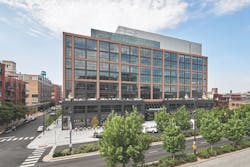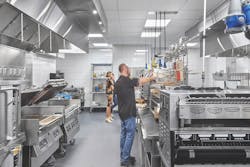Fast delivery: Construction of McDonald's global headquarters was completed in under seven months
Last June, McDonald’s moved into its new global headquarters in Chicago’s Fulton Market. It now occupies the entire 492,000 sf of the office space and portions of ground-floor retail space of a Class A, nine-story, 567,000-sf building in the city’s West Loop.
The interior construction was completed in just 6½ months. This fast-track schedule was maintained by top-down construction that allowed the concrete structure above ground to be built and fitted out simultaneously with the excavation and construction of the garage levels.
The rigorous schedule required close collaboration between the core-and-shell team, led by the project’s developer, and the interiors team, led by McDonald’s. That collaboration was facilitated by extensive use of BIM, with a heavy emphasis on the MEP systems for the headquarters’ test kitchens and labs on the second and third floors. The BIM process was compressed to 14 weeks, during which 4,500-plus man-hours were spent on BIM for interiors alone, resulting in time and cost savings.
The team addressed multiple challenges throughout the project's fast-track engagement. One was the installation of a prominent stair feature in the five-story atrium. The structural steel feature—which was not part of the project’s base building design—was hoisted onto the fourth floor through the curtain wall leave-out panel, then hoisted again by an internal crane onto each floor.
McDonald’s Hamburger University has three fully functional test labs, a static kitchen, and a mock dining area for training new employees.
Due to the large floor plates, noise abatement was also a concern. The team solved this problem by hanging thick felt material (Arktura) for sound dampening and as an aesthetic element. Specialty acoustic gypsum board (USG's Ensemble) was used in large gathering spaces and circulation paths.
The building has a remarkably diverse array of spaces that include “work neighborhoods”—dynamic workspaces with open floor plans and free-address seating. The neighborhoods have huddle rooms, communal tables, workstations, private phone rooms, and personal lockers. There are also “conversation areas” throughout the building that encourage serendipitous employee interaction.
The company’s internal marketing group, Agency 123, has a variety of studios within the building to enable quicker content turnaround. Another part of the headquarters showcases the company’s history through interactive exhibits, wall art, and other artifacts. The company commissioned two art installations, by artists Jessica Stockholder and Jacob Hashimoto, that weigh a total of one ton.
Another collaboration space is the Work Café on the sixth floor, with stadium seating and a tech bar to fulfill employees’ technological needs. Floor-to-ceiling windows that span two floors offer stimulating views of Chicago’s skyline. Views of downtown are also available from outdoor amenities spaces on the sixth and eighth floors.
A 700-person conference center on the third floor is equipped with technology for connectivity on a global scale. The project team worked with smart-building consultant JLL to implement features such as high-level AV integrations that connect McDonald’s employees in offices around the world.
The global innovation kitchen allows chefs to collaborate as they test and develop new product offerings. The equipment can be reconfigured in a couple of hours.
The conference center shares technology and MEP systems with the 40,000-sf Hamburger University learning center for new employees. That space contains three fully functioning laboratories, a static kitchen, and a mock dining area. The building has kitchens and walk-in coolers on the second and third floors, as well as a global innovation kitchen that is designed to allow chefs to collaborate in order to develop new products faster.
McDonald’s has nearly 38,000 restaurants worldwide, and its headquarters reflects its international presence in many ways. A ground-floor “Experience of the Future” restaurant features a rotating menu of favorites from a wide variety of countries. The restaurant offers self-order kiosks, table service, mobile order and payment, and McDelivery with Uber Eats.
The LEED-certified building has a green roof. All waste produced by its test kitchens is composted.
The opening of its new headquarters, where about 2,000 of its 210,000 employees work, was a kind of homecoming for McDonald’s, which was based in Chicago from 1955 to 1971. The company’s CEO, Steve Easterbrook, sees this return as “an important step in our journey to build a better McDonald’s that strives to get closer to our customers in everything we do."
Building Team — Submitting firm Executive Construction (GC, interior), Owner McDonald’s Corporation, Developer Sterling Bay Companies, Architects IA Interior Architects (interiors); Gensler (AOR, core and shell); Studio O+A (branding), SE Magnusson Klemencic Associates, MEP/FP/security engineer WMA Consulting Engineers, AV/cable/acoustics engineer Waveguide, Smart building consultant JLL, Atrium exhaust consultant Jensen Hughes, Commissioning agent Cyclone Energy GC (core and shell) James McHugh Construction
General information — Size 567,000 sf, Construction time, November 2017 to June 2018, Delivery method CM at risk


